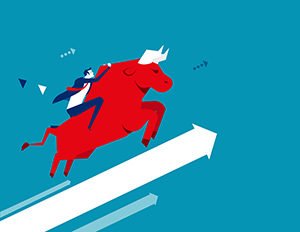Today (August 22), the bull market entered its 3,453rd day, making it the longest bull market in American history.
Investors everywhere are celebrating the incredible profits they've banked, but all good things come to an end...
Since the bull run started in March of 2009, the Dow Jones Industrial Average has risen nearly 20,000 points. The S&P 500 has quadrupled. The Nasdaq has risen nearly six times its 2009 value thanks to surging tech giants like Amazon.com Inc. (Nasdaq: AMZN) and Netflix Inc. (Nasdaq: NFLX).
 While returns have been phenomenal, the bull market's push into uncharted territory has many investors wondering if the market's best gains are in the rearview mirror.
While returns have been phenomenal, the bull market's push into uncharted territory has many investors wondering if the market's best gains are in the rearview mirror.
These investors may be on to something...
Rising volatility, high valuations, and troubling geopolitical developments are all signs the market is primed for a correction - or even a bear market.
However, these bearish indicators don't mean you have to lose money in the market - in fact, any market downturn can be a tremendous profit opportunity.
You just have to be prepared...
A Bear Market Is Coming - Here's How to Protect Your Portfolio
The reality is this bull market is in completely uncharted territory.
According to financial services company Ned Davis Research, there have been 37 bull markets since 1900 with an average length of 25 months.
Not only is today's bull market blowing past the 86-month record set in 1956, it's eclipsing the average bull market length by a full seven years.
Powerful Investment Income Stream: The Treasury is sitting on an $11.1 billion money pool. By adding your name to a special distribution list, you could begin collecting $1,795 or more every month. Get the details...
As a result, Wall Street is largely uncertain about how this bull market will behave as it continues to age.
One increasingly likely outcome is that it triggers the market's next significant correction.
According to a report from Deutsche Bank, a stock market correction occurs, on average, every 357 days - or about once a year.
During this record bull market, there have been a record amount of them - 15 of the 20 largest single-day point declines have occurred over the last 10 years.
On average, that's a correction every 240 days. It's been almost 200 days since the market's last correction.
As a result, you shouldn't be surprised if institutional investors - especially those invested in highly leveraged funds - use this historic milestone as an excuse to take profits and wait for the market to pull back.
And when this happens, you'll be able to make a killing - if your money is in the right place...
How to Protect Your Investments No Matter What the Bull Market Does Next
[mmpazkzone name="in-story" network="9794" site="307044" id="137008" type="4"]
If your investments are parked in popular, headline-grabbing stocks, you're likely to get burned the most during a correction. These companies are often highly overvalued and are the first to drop as investors flee the market.
Just look at Tesla Inc. (Nasdaq: TSLA). During the market's last correction in February, Tesla stock fell 12% over the course of just six trading days, wiping out enthusiastic investors who had jumped on the stock's media bandwagon.
This is why we encourage Money Morning readers to stick to stocks under Wall Street's radar - stocks that have tremendous growth potential and won't be rocked by tough market conditions.
Take McDonald's Corp. (NYSE: MCD) as an example. In 2007, the fast food giant had a price/earnings (P/E) ratio around 10, seven points lower than the average P/E ratio of the S&P 500.
McDonald's low P/E indicated that the company was undervalued and a buying opportunity, even as that bull market was nearing its end.
While stocks in the S&P 500 took a tremendous beating during the eventual crash in 2007 and 2008, McDonald's actually gained during the crisis.
But finding undervalued stocks can be difficult, especially this late in the market cycle.
In order to identify the best value stocks, we use the Money Morning Stock VQScore™ to uncover stocks with real growth potential.
Developed from our proprietary valuation system, the VQScore identifies undervalued stocks with the highest profit potential by using a blended analysis of a company's earnings potential, growth rate, earnings-per-share acceleration, and market volume.
But there are even more ways to protect your portfolio.
In fact, income-generating investments are one way to ensure a steady stream of cash even if stock prices are falling.
And we've uncovered an opportunity you won't hear about anywhere else...
Millions of Americans Now Entitled to Collect "Federal Rent Checks"
Forty-six years ago, Congress passed an obscure piece of legislation known as Public Law 92-313. And today, it's why the Treasury is sitting on top of an $11.1 billion pile of money.
Fortunately, Americans from coast to coast have discovered a loophole that entitles them to a sizable portion of this cash.
And they're racing to add their names to a special distribution list.
Some are now receiving monthly checks worth $1,795 each. Others are collecting $3,000, $5,000, or more every month. If you want to join them in this powerful investment income stream, you better hurry up.
Because this cash is getting scooped up left and right! Read more...


